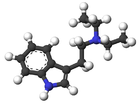This article's factual accuracy is disputed. (October 2011) |
DET, also known under its chemical name N,N-diethyltryptamine and as T-9,[2] is a psychedelic drug closely related to DMT and 4-HO-DET. However, despite its structural similarity to DMT, its activity is induced by an oral dose of around 50–100 mg, without the aid of MAO inhibitors, and the effects last for about 2–4 hours.
 | |
 | |
| Clinical data | |
|---|---|
| ATC code |
|
| Legal status | |
| Legal status |
|
| Identifiers | |
| |
| CAS Number | |
| PubChem CID | |
| DrugBank | |
| ChemSpider | |
| UNII | |
| KEGG | |
| ChEMBL | |
| CompTox Dashboard (EPA) | |
| Chemical and physical data | |
| Formula | C14H20N2 |
| Molar mass | 216.328 g·mol−1 |
| 3D model (JSmol) | |
| Melting point | 169 to 171 °C (336 to 340 °F) |
| |
| |
| | |
Chemistry
editDET is an analogue of the common tryptamine hallucinogen N,N-Dimethyltryptamine or DMT.
Pharmacology
editThis section needs additional citations for verification. (October 2013) |
The mechanism of action is thought to be serotonin receptor agonism, much like other classic psychedelics.[3]
DET is sometimes preferred over DMT because it can be taken orally, whereas DMT cannot. This is because the enzyme monoamine oxidase degrades DMT into an inactive compound before it is absorbed. To overcome this, it must be administered in a different manner, i.e. intravenously, intramuscularly, by inhalation, by insufflation, rectally, or by ingestion along with an inhibitor of monoamine oxidase. Because DET has ethyl groups attached to its nitrogen atom, monoamine oxidase is unable to degrade it. This is also true for many other tryptamines with larger nitrogen substituents.
Biochemistry
editAlthough DET is a synthetic compound with no known natural sources, it has been used in conjunction with the mycelium of Psilocybe cubensis to produce the synthetic chemicals 4-PO-DET (Ethocybin) and 4-HO-DET (Ethocin), as opposed to the naturally occurring 4-PO-DMT (Psilocybin) and 4-HO-DMT (Psilocin). Isolation of the alkaloids resulted in 3.3% 4-HO-DET and 0.01-0.8% 4-PO-DET.[4]
Psychosis model
editEarly studies of DET as well as other psychedelics were focused on their presumed psychotomimetic properties.[5] Researchers theorized that abnormal metabolites of endogenous chemicals such as tryptamine, serotonin, and tryptophan could be the explanation for mental disorders such as schizophrenia, or psychosis.[6] With the progression of science and pharmacological understanding, this belief has been dismissed by most researchers.
Legal status
editInternationally DET is a Schedule I drug under the Convention on Psychotropic Substances.[7]
Australia
editDET is considered a Schedule 9 prohibited substance in Australia under the Poisons Standard (October 2015).[8] A Schedule 9 substance is a substance which may be abused or misused, the manufacture, possession, sale or use of which should be prohibited by law except when required for medical or scientific research, or for analytical, teaching or training purposes with approval of Commonwealth and/or State or Territory Health Authorities.
See also
editReferences
edit- ^ Anvisa (2023-07-24). "RDC Nº 804 - Listas de Substâncias Entorpecentes, Psicotrópicas, Precursoras e Outras sob Controle Especial" [Collegiate Board Resolution No. 804 - Lists of Narcotic, Psychotropic, Precursor, and Other Substances under Special Control] (in Brazilian Portuguese). Diário Oficial da União (published 2023-07-25). Archived from the original on 2023-08-27. Retrieved 2023-08-27.
- ^ "Erowid DET Vault : Chemistry". Retrieved 2008-01-08.
- ^ Winter JC (September 1969). "Behavioral effects of N,N-diethyltryptamine: absence of antagonism by xylamidine tosylate". The Journal of Pharmacology and Experimental Therapeutics. 169 (1): 7–16. PMID 5306645.
- ^ Gartz J (1989). "Biotransformation of tryptamine derivatives in mycelial cultures of Psilocybe". Journal of Basic Microbiology. 29 (6): 347–52. doi:10.1002/jobm.3620290608. PMID 2614674. S2CID 43308695.
- ^ Böszörmenyi Z (1960). "Psilocybin and diethyltryptamine: Two tryptamine hallucinogens". Neuro-psychopharm. 2: 226–9.
- ^ Khazan N, McCash D (April 1965). "Effects of LSD-25, n,n-dimethyltryptamine (DMT), and N,N-diethyltryptamine (DET) on the photic evoked responses in the unanesthetized rabbit". Archives Internationales de Pharmacodynamie et de Therapie. 154 (2): 474–83. PMID 5839429.
- ^ International Narcotics Control Board (August 2003). "List of psychotropic substances under international control" (PDF). Archived (PDF) from the original on 2 March 2007. Retrieved 30 March 2007.
- ^ "Poisons Standard". Federal Register of Legislation. Australian Government. October 2015.